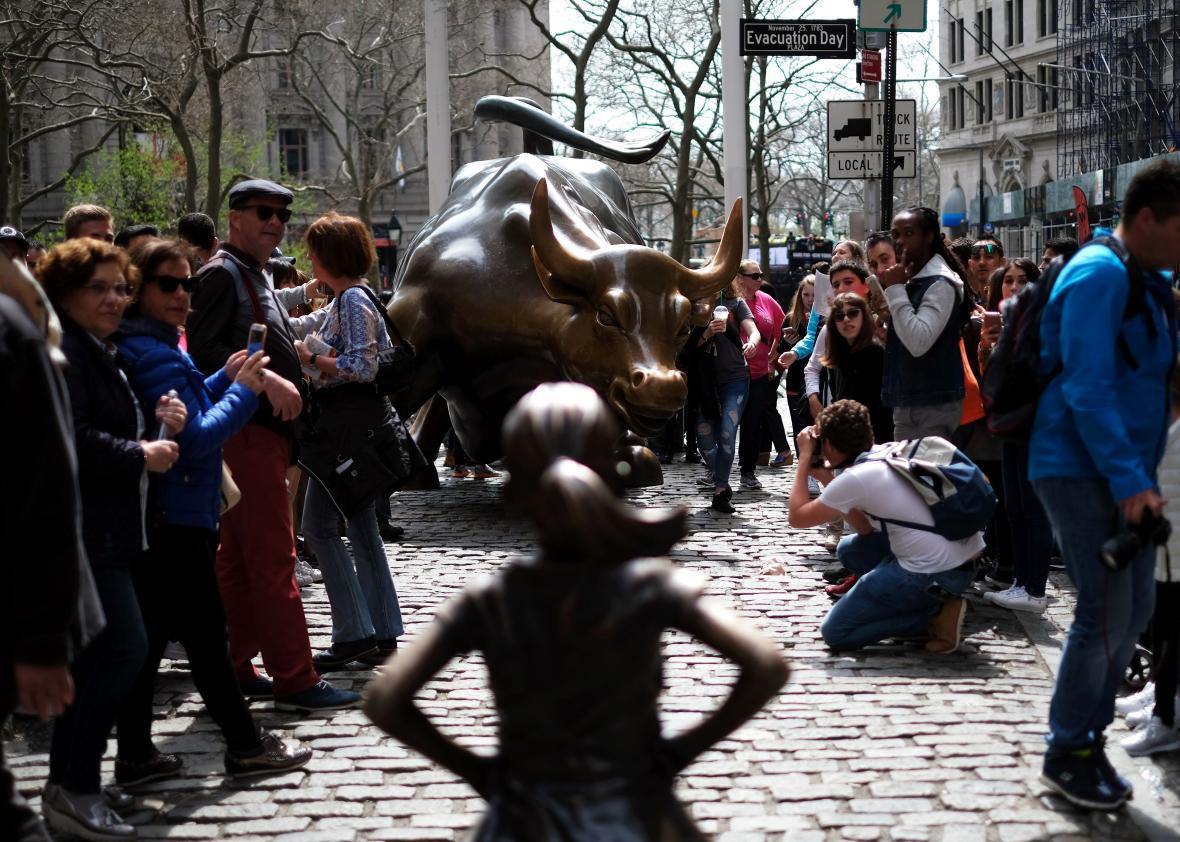Wall Street’s Fearless Girl statue has weathered more than her fair share of mischief since she was erected the night before International Women’s Day. Just two days after her arrival in the Big Apple, she got humped by a man in a suit miming child rape. A few weeks later, supporters of our dear President Donald Trump nonconsensually draped her in MAGA gear and anti-immigrant placards.
Now, the sculptor of the decades-old Charging Bull statue the girl “fearless”-ly faces down is claiming she doesn’t belong there in the first place. Artist Arturo Di Modica, who installed his bull sculpture under the cover of night after the 1987 stock-market crash, called on Wednesday for New York City authorities to remove the girl statue, saying it violates his rights as an artist.
Di Modica knows a thing or two about using public acclaim to force an art piece onto city property. He didn’t have a permit when he erected his piece outside the New York Stock Exchange, but after it became a tourist attraction, the city agreed to let it stay. Likewise, sculptor Kristen Visbal’s Fearless Girl was meant as a temporary month-long installation. But Mayor Bill de Blasio announced in March that, in part due to the sculpture’s booming popularity, it would remain until February 2018.
There’s no question that Fearless Girl derives its meaning from its interaction with Di Modica’s piece. Crafted in the same medium as the bull, the girl stands meters away on the traffic island, making what looks to be direct eye contact with the animal. Without Di Modica’s sculpture, Fearless Girl is just a girl. With it, she’s a symbol of women braving the sexual harassment and gender discrimination of Wall Street to rise in a male-dominated field.
Reverse that equation, and you get a good case for Di Modica’s claims. Before Fearless Girl came on the scene, the bull was an encouraging representation of a booming economy. Now, charging toward a tiny human, it’s a stand-in for the gendered forces that work against women’s success in the workplace. This isn’t the same kind of contextual shift that might result from a curator’s juxtaposition of two works; the girl is derivative. Di Modica meant his bull to stand alone—now, it’s as if Visbal and New York City have made a solo piece a diptych without his consent.
Though it’s rarely been invoked, the Visual Artists Rights Act of 1990 protects artists from having their works destroyed, moved, or altered under specific circumstances. Di Modica may have been able to argue a violation of his copyright under VARA if he could convince a judge that the city modified his work or damaged its integrity in a way that harmed his reputation, which the city almost certainly did. But the law doesn’t apply to artworks created before the law’s enactment, meaning Di Modica will have to find another legal basis if he decides to sue the city. In a press conference on Wednesday, the artist’s attorney demanded that city authorities point to any documents that might show they acted within the bounds of established procedure when they okayed Fearless Girl.
De Blasio has come out with a Matt McGorry degree of conspicuous support for Fearless Girl, tweeting on Wednesday that “men who don’t like women taking up space are exactly why we need the Fearless Girl,” an apparent burn directed at Di Modica.
This is a blatant mischaracterization of Di Modica’s very valid argument that the city is altering his artwork—and potentially damaging his reputation—by adding another sculpture in direct conversation with his work without his sign-off. But de Blasio seems intent on pushing Fearless Girl as a corrective to the sexism on Wall Street and everywhere, seizing an opportunity to burnish his administration’s feminist bona fides on the tails of the Women’s March and its attendant activism. When the mayor announced that Fearless Girl would remain for another year, he boasted that its seeming message of empowerment “spoke to the moment” and was “inspiring everyone.”
What exactly the defiant little girl says about “the moment” is up for debate. Feminists would be hard-pressed to find a better symbol of the movement’s widening class divides than Fearless Girl. Commissioned by State Street Global Advisors, a wing of a massive financial services company, Visbal’s work is meant to draw attention to the lack of women on corporate boards. As Jia Tolentino ably lays out in the New Yorker, contemporary feminism’s fixation on the incremental admission of a small number of women into traditional halls of power ignores both the vast majority of women and the ways other forms of oppression disproportionately harm women. Fearless Girl’s school of feminism, to the extent that she represents one, is shallow and apolitical. It doesn’t help that the State Street Corporation counts just three women on its board of 11, or that the company’s advertising firm chose to represent women’s career empowerment with an image of a child.
